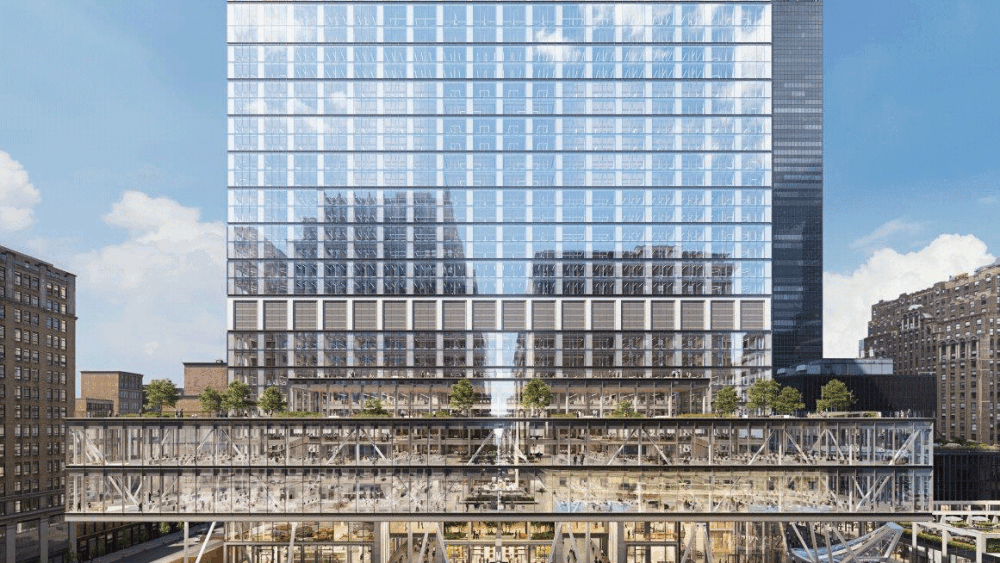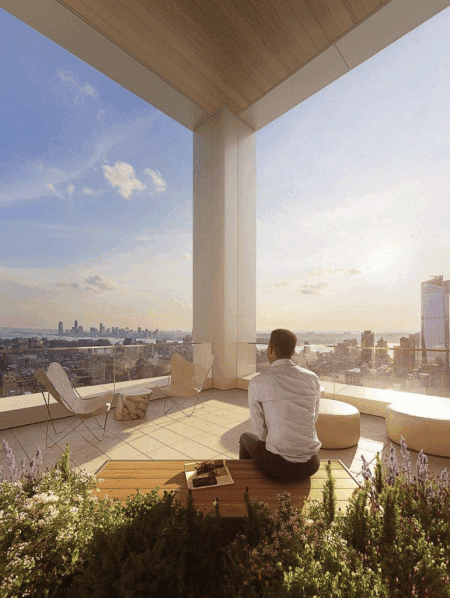One of New York City’s busiest corridors is set for one of its biggest transformations in years. The area around Manhattan’s Penn Station has long been considered a sore spot for the city, as top-tier retail stores moved to more flourishing areas and local buildings became outdated. But now, with a billion-dollar plan by a New York state agency underway to revitalize public transit infrastructure in and around Penn Station, there is serious momentum for the Midtown neighborhood, which has stalled in growth as surrounding neighborhoods have evolved.
At the same time, Vornado Realty Trust is repositioning two of its office towers atop Penn Station: Penn 1 and Penn 2. With Penn 1 already completed, Penn 2 is now taking shape and nearing completion, and it’s a milestone that comes with a lot of promise for the future of the area.
Storied history
Penn Station is the busiest transportation hub in the country. Hundreds of thousands of people pass through the station on a given weekday, where several transit lines converge: the city’s subway system, New Jersey Transit rail lines, Amtrak, and Long Island Rail Road.
When first built in 1910, it was a grand station done in the Beaux Arts style with Romanesque marble columns and pink granite. The iconic train station changed forever in 1963, however, when the above-ground component of the structure, known as the “head house,” was demolished to make way for Madison Square Garden, a move that garnered much public opposition at the time. The decision became infamous in the decades that followed, with many people expressing dismay over what has been called one of the worst changes in the history of the city.
The constant flow of commuters and tourists keeps the neighborhood bustling, as do the major sporting and entertainment events at Madison Square Garden. Many of the surrounding buildings and retail offerings have languished, however, leading to calls for Penn Station to be revamped and the area revitalized.
The state did just that when it announced a $7 billion makeover of Penn Station in 2021. Plans call for opening up the station by letting in more light, widening corridors, and turning the multilevel layout into a single-level train hall. The plan has had its ups and downs since it was first announced.
Originally, Vornado was set to develop several office towers that would help pay for the train station overhaul, but that agreement has since been abandoned, with New York Governor Kathy Hochul saying the state would be “decoupling” the Penn Station overhaul from a plan to fund it through the development of several office towers nearby.
Still, Vornado is moving forward with completing Penn 2 this spring. With transformative plans for the office space it owns, Vornado wants to change not only the buildings in the neighborhood but also the perception and profile of the Penn District. “We’re creating a real new district in a district that has been starved of [many improvements] forever,” says Glen Weiss, executive vice president of office leasing at Vornado, pointing to the additions that the Penn District will bring, including new public plazas, wider sidewalks, additional trees, and new retail stores. “That’s the theme.”
In with the new
Beginning in the 1980s, Vornado began buying up office properties around Penn Station, eventually assembling a campus of 10 million square feet (930,000 sq m) of office space in what company leaders now call the Penn District. Today, the company is in phase one of its plan for the Penn District, which comprises 5.5 million square feet (511,000 sq m) of repositioning office space.
The first chunk of space in the phase was the Farley Post Office project, where Facebook’s parent company, Meta, ended up leasing the entirety of the 740,000 square-foot (69,000 sq m) office portion of the property. The first phase also includes the redevelopment of Penn 1, which has 2.5 million square feet (232,000 sq m) of office space, and Penn 2, which will have 1.8 million square feet (167,000 sq m).
Formerly known as Two Penn Plaza, Penn 2 is a 31-story office tower built atop Penn Station in 1968. Vornado is spending $750 million to reposition the property, which is adjacent to an expansive public plaza and is on a double-wide block, one of the few that exist in Manhattan.
One of the most distinctive parts of the tower’s revamp is the addition of a new structure to the podium floors of the building, a feature the developer calls the “bustle.” The added space wraps around the front of the building, spanning the entire block on 7th Avenue between West 31st and West 33rd streets.
Major changes to the building included adding a glass curtain wall to let in more light, something the building didn’t have much of before. The new windows are triple glazed, which reduces energy consumption; an antiquated and cumbersome mechanical system that was located near the windows of the building was updated; and elevator systems were upgraded to offer destination dispatch, which also increases efficiency. Vornado is targeting LEED Platinum for the building.
Creating a variety of workspace options and outdoor space was an important design consideration. Terraces were added to every floor on the west side of the building, offering outdoor space to work in. A 4,000 square-foot (372 sq m) multi-use pavilion within the bustle is available for tenants to use, and a 17,000 square-foot (1,580 sq m) landscaped park was added to the roof of the bustle. Building occupants will have numerous lounges throughout the building where they can work, with food and beverage offerings at each location.
The repositioning of Penn 1 and Penn 2 came about slowly and carefully, said Dan Shannon, managing partner at New York City-based architecture firm MdeAS, one of the firms that designed Penn 2. “Vornado was very deliberate. They didn’t do anything quickly and ad hoc,” Shannon said.
Discussions between MdeAS Architects and Vornado began nearly a decade ago, when Shannon first spoke with Vornado CEO and Chairman Steve Roth and his executive team about initiating studies on improvements to Penn 1 and Penn 2. Those talks focused on designing the properties to be more modern office buildings.
Updating spaces where visitors walk distinguishes the buildings and the area. “Every walking surface in Penn 1 and Penn 2 has new pavement,” Shannon said—specifically, a stone from Belgium. “It really creates a district, like when you’re in Tribeca and you see all the flagstone—Steve [Roth] really wanted to create a sense of a district and make the investment to distinguish the area.”
A neighborhood evolves
Vornado’s big bet on office raised eyebrows when plans were announced. The office market in New York and across the country has struggled since the pandemic, leading to a lot of uncertainty about the future. However, some experts believe the sector will eventually rebound. “Real estate is cyclical, and so is the economy,” said Matthew Kwatinetz, a clinical assistant professor of real estate economics and the director of the NYU Urban Lab.
Office space construction has slowed significantly over the last several months, and the nation’s total office stock is actually shrinking for the first time in history, according to commercial real estate firm JLL. “There’s no question about the long-term demand for office space,” he said. “There is a question [over whether] landlords will be able to survive until then.”
One of the biggest issues for New York City’s office market revolves around the quality of space available. In today’s competitive market, where the flight-to-quality trend has persisted, high-profile occupiers are looking for top-tier spaces that meet their needs.
“Tech didn’t move here until they renovated buildings,” Kwatinetz explained, pointing to Facebook parent company Meta’s lease at Vornado’s Farley Post Office redevelopment and Google’s purchase of the St. John’s Terminal building for $2.1 billion in early 2022. “All those [moves], despite the doom and gloom, are receiving higher rents than anything in history,” Kwatinetz said. “It’s a very high-demand product.”








